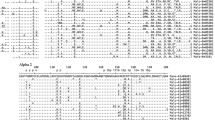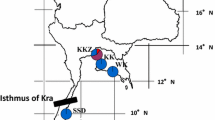Abstract
A macaque population produced by the hybridization of native Japanese macaques (Macaca fuscata) and introduced Taiwanese macaques (M. cyclopis) in Wakayama Prefecture was shown to possess three DNA haplotypes of the natural resistance-associated macrophage protein 1 (NRAMP1). Based on genotyping and comparison with M. fuscata populations, it was revealed that the introduced M. cyclopis population was polymorphic for the NRAMP1 locus. Extensive crossbreeding of the introduced species with the native species was confirmed using this genetic marker and the proportion of M. cyclopis genes was 57.4%. Results of statistical tests suggested non-random mating in the hybrid population.


Similar content being viewed by others
References
Deinard A, Smith DG (2001) Phylogenetic relationships among the macaques: evidence from the nuclear locus NRAMP1. J Hum Evol 41:45–59
Ecological Society of Japan (2002) Handbook of alien species in Japan (in Japanese). Chigin Shokan, Tokyo
Evans BJ, Supriatna J, Melnick D (2001) Hybridization and population genetics of two macaque species in Sulawesi, Indonesia. Evolution 55:1686–1702
IUCN (2000) IUCN guidelines for the prevention of biodiversity loss caused by alien invasive species. IUCN SSC Invasive Species Specialist Group, Gland, Switzerland
Kawamoto Y, Shirai K, Araki S, Maeno K (1999) A case of hybridization between the Japanese and Taiwanese macaques found in Wakayama Prefecture (in Japanese with English summary). Primate Res 15:53–60
Kawamoto Y, Ohsawa H, Nigi H, Maruhashi T, Maekawa S, Shirai K, Araki S (2001) Genetic assessment of a hybrid population between Japanese and Taiwanese macaques in Wakayama Prefecture (in Japanese with English summary). Primate Res 17:13–24
Nijman IJ, Otsen M, Verkaar ELC, de Ruijter C, Hanekamp E, Ochieng JW, Shamshad S, Rege JEO, Hanotte O, Barwegen MW, Sulawati T, Lenstra JA (2003) Hybridization of banteng (Bos javanicus) and zebu (Bos indicus) revealed by mitochondrial DNA, satellite DNA, AFLP and microsatellites. Heredity 90:10–16
WRI (1992) Global biodiversity strategy: guidelines for action to save, study and use earth’s biotic wealth sustainably and equitable. World Resources Institute, World Conservation Union (IUCN), and the United Nations Environment Programme, Washington D.C.
Acknowledgements
I wish to thank prefectural authority of Wakayama Prefecture for allowing me the opportunity to undertake this study. I am indebted to Mr. Kei Shirai and other members of Wildlife Management Office, Kawasaki, Japan, for sample collection and information. I am grateful to Mr. Shingo Maekawa, Drs. Hideo Nigi, Hideyuki Ohsawa, Shunji Gotoh, Yasuyuki Muroyama, Tamaki Maruhashi and Harumi Torii for their help and cooperation. I also thank Dr. Jan R. de Ruiter for helpful suggestions on the manuscript. This study was supported in part by Grants-in-Aid for General Scientific Research (13440256 and 16310156) and the MEXT Grant-in-Aid for the 21st Century COE Program (A2 to Kyoto University) from the Ministry of Education, Culture, Sports, Science and Technology, Japan.
Author information
Authors and Affiliations
Corresponding author
About this article
Cite this article
Kawamoto, Y. NRAMP1 polymorphism in a hybrid population between Japanese and Taiwanese macaques in Wakayama, Japan. Primates 46, 203–206 (2005). https://doi.org/10.1007/s10329-004-0119-3
Received:
Accepted:
Published:
Issue Date:
DOI: https://doi.org/10.1007/s10329-004-0119-3




